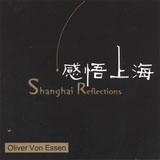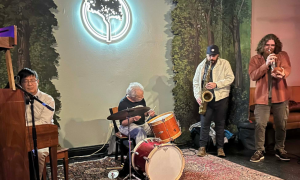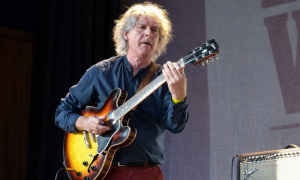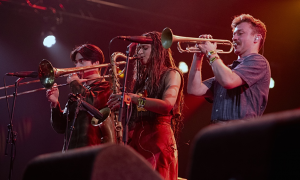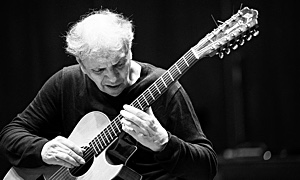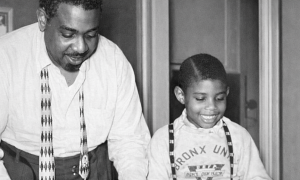Home » Jazz Articles » Live Review » Ottawa Jazz Festival Day 6: June 26, 2007
Ottawa Jazz Festival Day 6: June 26, 2007
At its half-way point, the 2007 TD Canada Trust Ottawa International Jazz Festival's sixth day presented a series of concerts that demonstrated just how broad repertory jazz can be. While too many artists retread overly played material and bring nothing new to the table, the performances at the 5:00 PM Connoisseur Series, 8:30 PM Concert Under the Stars events, and 10:30 PM Studio series demonstrated that, with strong source material and the right artists, there's always room to bring fresh, innovative and even exploratory perspectives to the most heel-worn songs.
Chapter Index
Aki Takase Project Plays Fats Waller
That the music of the short-lived but hugely influential pianist- composer-entertainer Fats Waller (1904-1943) can provide grist for a show combining reverence for the music with some of the most liberal reworkings imaginable might seem, on first glance, a mismatch made somewhere other than heaven—until one considers who is taking on the project. Japanese-born pianist Aki Takase, who has been living in Germany for many years now, has a background more associated with free jazz than stride piano, including work with artists such as Alex Von Schlippenbach, David Murray and Reggie Workman. But her unusually configured Fats Waller Project—with bass clarinetist Rudi Mahall, trombonist Nils Wogram, drummer Paul Lovens and banjoist/guitarist/vocalist Eugene Chadbourne—brought not only extra abandon to Waller's widely known repertoire but an absurd and strangely appropriate theatrical sense of humor, making even the most outrageous moments of the set at once entertaining and accessible to a capacity crowd.Yet another example of how the same piano can sound like a completely different instrument depending on who's playing it, the diminutive Takase's aggressive attack and sound was in sharp contrast to Renee Rosnes' more fluid tone. Still, on an exceptionally melancholy version of "Auld Lang Syne" programmed near the end of the eighty-minute set, Takase demonstrated a more elegant touch.
Bass clarinet is rarely heard as a primary instrument, at least not since Eric Dolphy, but here it fit right in. Not quite as robust as a saxophone, it nevertheless possesses a deep, warm and woody tone, though during some of the show's more chaotic moments Mahall gave it an edgier growl. Equally, Wogram made the trombone a remarkably breathy instrument at times, though he also made it brash when necessary. Lovens was a flexible player who navigated the more carefully orchestrated parts of Takase's charts while bringing a reckless abandon to the table when called for.
However, the hands-down pick for most entertaining member of the group was Chadbourne, whose performance at Victoriaville, Canada's 2007 edition of FIMAV with Kevin Blechdom was both immensely entertaining and indicative of just how wide that festival's reach is. Chadbourne's often hilarious vocal takes on famous Waller songs, including "Lookin' Good But Feelin' Bad" and the uproarious "The Joint is Jumpin,'" on which Chadbourne put down his banjo and interacted more directly with his bandmates, were highlights of the set. He also proved himself to be a talented banjoist, something that was less evident at his more structured song-centric set at FIMAV.
There was plenty of tradition to be heard throughout a set that also included Waller's classic "Ain't Misbehavin,'" but Takase's charts could veer from retro stride piano to Cecil Taylor-like assaults from one moment to the next. And when the frontline horns kicked into free improv mode, the mostly acoustic setup filled the room without the need (Takase's piano aside) for instrument miking. A good thing, too, since this will likely go down as the loudest performance of the Connoisseur Series. It was a performance that demonstrated how less accessible, even challenging music-making can be made palatable to an audience through the innovative adaptation of well-known songs.
Don Byron Plays Junior Walker
When Don Byron, best-known as an eclectic clarinetist on albums such as the marvelous Tuskeegee Experiments (Nonesuch, 1992) and Romance With The Unseen (Blue Note, 1999), began playing saxophone on Ivey Divey (Blue Note, 2004), it came as something of a surprise. Doin' the Boomerang (Blue Note, 2006), which he's been touring since fall, 2006, finds him almost exclusively on the tenor, with only a couple of nods to his main axe.Byron's performance at the 2007 Portland Jazz Festival, while thoroughly engaging, was disadvantaged when guitarist David Gilmore had to bow out at the last minute due to a death in the family. One of the greatest strengths about this particular project is that, while the music is gritty R&B, everyone in the band has a significant jazz pedigree. Having to fill in at the last minute with schooled and well-honed professionals is the kind of challenge that many could not rise to. Seattle guitarist Thaddeus Turner was a more died-in-the-wool blues guitarist and, while he didn't drag the group down, neither did he pick them up. With Gilmore back for Byron's Ottawa appearance, it became clear just how important each and every member of a carefully constructed band is.
Equally, with ex-Living Colour drummer Will Calhoun performing in Portland, the return of Rodney Holmes (the drummer on the Boomerang CD) to the drum throne in Ottawa meant that the core group from the album, also featuring singer Dean Bowman, bassist Brad Jones and organist George Colligan, was back together again. Its greatest strength as a cohesive unit was to play Walker's material with the credibility and respect it deserved while, at the same time, taking it places Walker would never have imagined possible.
Colligan, in particular, delivered solo-after-solo of visceral energy, demonstrating an ability to take things ever so slightly out and creating a wonderful tension that released only when he reeled himself back in, notably on the set-opener, "Cleo's Mood." If John Scofield played organ rather than guitar, he might sound like this.
A terrific front man and singer, Bowman's voice was far-reaching, capable of growls, moans and odd yodel-like ululations alongside a loose delivery that was as much fun to hear as it was to watch.
Gilmore was the kind of rhythm player who could take the extended, one-chord vamp of James Brown's "There It Is" and, coupled with the booty-shaking groove from Jones and Holmes (who is also a member of Colligan's Mad Science organ trio, responsible for the fiery, Tony Williams Lifetime-inspired Realization), keep it cooking without any lags. He played with Hendrix-like psychedelic spontaneity on his solo intro to "Ain't That the Truth," while keeping the groove moving relentlessly forward on the more up-tempo "Pucker Up Buttercup."
Probably the only project he's done on which audiences can expect to see him getting down with his "bad" self, Byron's tenor solos were strong, but when he brought out his clarinet for a solo on "(I'm a) Roadrunner," it became clear where his biggest strength lay.
The only disappointment was the relatively low audience turnout. Byron's performance was unequivocally the party band show of the 2007 OIJF. More's the pity, then, for those who missed a kick-ass gig that combined danceable grooves, largely familiar songs and muscular playing with a broader jazz vernacular, into a mix that took the music of Junior Walker straight into the jazz stratosphere.
Toots Thielemans and Kenny Werner
The second of three special-ticketed events at the 2007 OIJF, the appearance by harmonica legend Toots Thielemans and pianist Kenny Werner was one that the festival had been trying to book for some time. Thielemans, now 85, may have needed Werner's help to get him to and from his stool beside the piano but, like Dave Brubeck earlier in the week, once he began to play, the years simply melted way. With a largely standards-based set that included his own "Bluesette," it was a relaxed, unhurried performance. And in the smaller, more intimate setting of the National Arts Center Studio, it was even better than the duo's undeniably excellent show in the larger concert hall setting of Place Des Arts' Theatre Maisonneuve at the 2005 Montreal Jazz Festival.It was the perfect late-night show: sublime and understated, sharply contrasting with the day's earlier performances. The energy rarely reached a simmer, but the sold-out audience was thoroughly captivated and, like the UMO Jazz Orchestra's performance in the same space the previous evening, found few people, if any, leaving before the show was over—a common occurrence at the Studio series. Unlike UMO, however, with its larger-than-life, brass-heavy soundscape, there were more than a few moments during the Thielemans/Werner performance where the "pin drop" metaphor was a reality.
The set was defined by grace and deep lyricism. The material bore some degree of arrangement, representing a cross-section of classic composers, including Bill Evans, Michel Legrand, Henry Mancini, George Gershwin and Herbie Hancock. The end points of the trip were pre-arranged, but the fun was in the journey. Thielemans' facility and ability to find singable melodies through even the most challenging of changes was a constant delight. Werner is known as a pianist who truly treats every performance, regardless of context, as a new experience; but with the longstanding relationship these two share, the level of interaction was so subconscious and immediate that it bordered on the telepathic.
Werner also used a synthesizer to add lush orchestral pads on select tunes. But while a synthesizer might have seemed out of place in a performance where space was in itself a powerful instrument, as was an overriding feeling of quiet, Werner's ability to make it a nuanced and expressive instrument resulted in an organic expansion of the aural landscape.
Thielemans did most of the between-song speaking and, in deference to Ottawa's bilingualism and his own multi-linguistic background from his native Belgium, spoke largely in French. More akin to being in a home where the host is conversing with his guests, Thielemans' introductions provided insight into a man who has rubbed shoulders with jazz royalty throughout his sixty year-plus career and, of course, is nothing short of sovereignty himself.
For an 85-year-old to be wrapping up a performance at midnight, it was equally remarkable that he still had energy left for an encore. Werner, largely on the synthesizer, accompanied Thielemans on an almost achingly beautiful version of Louis Armstrong's classic "What a Wonderful World." A perfect ending to a day of largely known material, performed by three groups of artists whose own artistry ensured that nothing so much as remotely resembled a tired-out retread.
Tomorrow: ICP Orchestra.
Day 1 | Day 2 | Day 3 | Day 4 | Day 5 | Day 6 | Day 7 | Day 8 | Day 9 | Day 10 | Day 11
Tags
PREVIOUS / NEXT
Support All About Jazz
 All About Jazz has been a pillar of jazz since 1995, championing it as an art form and, more importantly, supporting the musicians who make it. Our enduring commitment has made "AAJ" one of the most culturally important websites of its kind, read by hundreds of thousands of fans, musicians and industry figures every month.
All About Jazz has been a pillar of jazz since 1995, championing it as an art form and, more importantly, supporting the musicians who make it. Our enduring commitment has made "AAJ" one of the most culturally important websites of its kind, read by hundreds of thousands of fans, musicians and industry figures every month.



